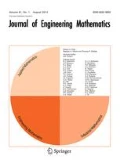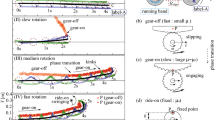Abstract
In ancient bows the grip of the bow was in the way of the arrow. The arrow needed to get round the bow while being accelerated; this phenomenon is called the ‘Archer's Paradox’. In the forties it was observed experimentally with high-speed cameras that the arrow vibrates in a horizontal plane perpendicular to the vertical median plane of the bow. These movements are started and controlled by the movements of the two points of contact with the bow, viz. the middle of the string in contact with the rear end of the arrow and the grip where the arrow slides along the bow. The latter contact imposes a moving-boundary condition. The numerically obtained results are satisfactorily in agreement with experimental data. The model can be used to estimate the drawing force of ancient bows of which only the contemporary arrows are available and also for the design of new archery equipment.
Similar content being viewed by others
References
C. N. Hickman, F. Nagler, and P. E. Klopsteg. Archery: the technical side. Redland (CA): National Field Archery Association (1947) 281pp.
R. Hardy. Longbow. Sparkford (Somerset, UK): Patrick Stephens Limited (1992) 244pp.
W. F. Paterson. A “Mary Rose” archery symposium. Journal of the Society of Archer-Antiquaries 26 (1983) 49–51.
R. Pekalski. Modelling and simulation research of the competitor-bow-arrow system (in Polish). PhD thesis, Academy of Physical Education, Warsaw (1987) 122pp.
R. Pekalski. Experimental and theoretical research in archery. Journal of Sports Sciences 8 (1990) 259–279.
B. W. Kooi. On the Mechanics of the Bow and Arrow. PhD thesis, Rijksuniversiteit Groningen (1983) 211pp.
B. W. Kooi and J. A. Sparenberg. On the static deformation of a bow. Journal of Engineering Mathematics 14 (1980) 27–45.
B. W. Kooi. On the mechanics of the bow and arrow. Journal of Engineering Mathematics 15 (1981) 119–145.
B. W. Kooi. On the mechanics of the modern working-recurve bow. Computational Mechanics 8 (1991) 291–304.
C. Gallozzi, L. M. Leonardi, A. Pace, and G. Caselli. A new method to measure lateral bow accelerations during shooting in archery. In: G. Bergmann, R. Kölbel, and A. Rohlmann (eds.), Biomechanics: Basic and Applied Research (1987) pp. 639–644.
L. M. Leonardi, C. Gallozzi, A. Pace, and A. Dal Monte. Reduction of lateral bow displacement using different torque flight compensators and stabilizers in archery. In: G. Bergmann, R. Kölbel, and A. Rohlmann, editors, Biomechanics: Basic and Applied Research (1987) pp. 633–638.
Author information
Authors and Affiliations
Rights and permissions
About this article
Cite this article
Kooi, B., Sparenberg, J. On the mechanics of the arrow: Archer's Paradox. Journal of Engineering Mathematics 31, 285–303 (1997). https://doi.org/10.1023/A:1004262424363
Issue Date:
DOI: https://doi.org/10.1023/A:1004262424363




